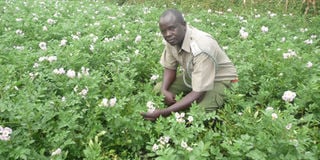Prison excels in crop and animal husbandry

G.K Kilgoris Prison farm manager Jacob Shapaya at the lock-up's experimental potato farm. The farm manager says besides engaging the inmates, farm work equips them with crop and animal husbandry skills which would become their lifeline when they finish their terms. PHOTO | JOEL REYIA | NMG
What you need to know:
- Unlike other correctional facilities, the prison is slowly gaining reputation for its mass food production.
- Statistics show that there were about 55,000 prisoners held in 118 government facilities countrywide in 2015, and this keeps on increasing as more convicts are put behind bars each year.
- The prison’s officer-in-charge Kennedy Locho said that if and whenever the prison department gives them the nod, they usually sell the surplus produce, thus generating revenue for the department.
- The animals are healthy and sleek as they have plenty of natural pasture and napier grass to feed on, and are routinely dipped and vaccinated against diseases.
Nestled deep in the heart of Trans Mara in Narok County is a correctional facility which is barely six years old.
Government of Kenya Kilgoris Prison is located at Mutenkuar trading centre, a 20-minute drive from Kilgoris town, the sub-county’s administrative headquarters.
Unlike other correctional facilities, the prison is slowly gaining reputation for its mass food production.
It sits on a 25-acre piece of land which the authorities have striven to optimise its production potential.
If you visit its vast farms on any particular day, you are bound to meet Jacob Shapaya, the lock-up’s farm manager doing his rounds.
On Thursday this week, the farm was particularly a beehive of activity, being the peak of the second harvest season in Trans Mara.
An old microvan filled with produce made trips from the farm to the store, driving through maize and vegetable farms.
Mr Shapaya who holds a Bachelor of Science degree in Aquatic Science and Fisheries from Moi University said the prison is able to cater for most of its internal food requirements.
He said that readily available labour from the inmates is utilised to cultivate maize, kales, tomatoes, potatoes and water melons which are then fed to the prisoners.
“Foodwise, we are secure because the annual maize yield is sufficient to feed our 400 prisoners and sometimes there is a surplus,” said Mr Shapaya, adding that they produce between 20 to 25 sacks of maize per acre in every harvest.
The prison’s officer-in-charge Kennedy Locho said that if and whenever the prison department gives them the nod, they usually sell the surplus produce, thus generating revenue for the department.
He said that besides engaging the inmates, farm work equips them with crop and animal husbandry skills which would become their lifeline when they finish their term.
“Some people serve time because of stealing, but when they come here they are taught new farming techniques which guarantees them financial and economic independence when they leave here,” said Mr Locho, adding that food self-sufficiency is all the more necessary in the face of an increase in prison population.
Statistics show that there were about 55,000 prisoners held in 118 government facilities countrywide in 2015, and this keeps on increasing as more convicts are put behind bars each year.
Mr Shapaya said that challenges such as pests, diseases and the lack of farm machinery negatively impacts on their productivity
MODERN LIVESTOCK HUSBANDRY PRACTICES
‘We also rear dairy cows whose dung we use to make organic fertiliser which acts as a good alternative to purchasing expensive chemical fertilisers which otherwise leave the soil poorer in the long run,’ said Mr Shapaya.
To make the fertiliser, the pile method is used. A shallow trench is dug under a tree shade within the garden, enough to bury the plant and animal matter.

Inmates carry bags of harvested maize in the facility's farm. Labour from the inmates is utilised to cultivate maize, kales, tomatoes, potatoes and water melons which are then fed to the prisoners. PHOTO | JOEL REYIA | NMG
Successive layers of maize cobs or maize stalks and cow dung, each of them sprinkled with water to make them moist, are laid on the trench. A layer of ash to regulate the PH is laid on top before it is completely covered.
Mr Shapaya said that the crop and animal residues are left to decompose for three to four months after which they are ready for use.
He said they have also introduced crop rotation to maintain soil fertility.
The penal institution keeps about 15 exotic breeds of cows, mainly Friesian and Ayrshire, which supplies the necessary milk for tea-making.
The animals are healthy and sleek as they have plenty of natural pasture and napier grass to feed on, and are routinely dipped and vaccinated against diseases.
This has made the penal institution’s farm a demonstration farm of sorts as the neighbouring Maasai people who mainly keep indigenous breeds of cows frequently come to learn modern livestock husbandry practices.
Mr Shapaya said that the pastoralists are often eager to have their small East African Zebu heifers crossed with the improved Friesian bulls so as to get improved breeds.
‘Usually we inspect the heifer very carefully to make certain that it is healthy and free of disease vectors before we allow it to mate with our bulls,’ said Mr Shapaya.
Mr Locho said that since this is done for free, it has improved the relations between the facility and the neighbouring community which often quickly alerts the prison guards in case a prisoner escapes.
He said an irrigation network in the pipeline would enable them to start producing food all-year round and reduce their dependence on rain-fed agriculture.
“Last year, we drilled a borehole and this is going to help us pump water to the farms to irrigate them. In addition, we have constructed a fish pond and will soon buy fingerlings to start rearing fish,” said Mr Shapaya.




